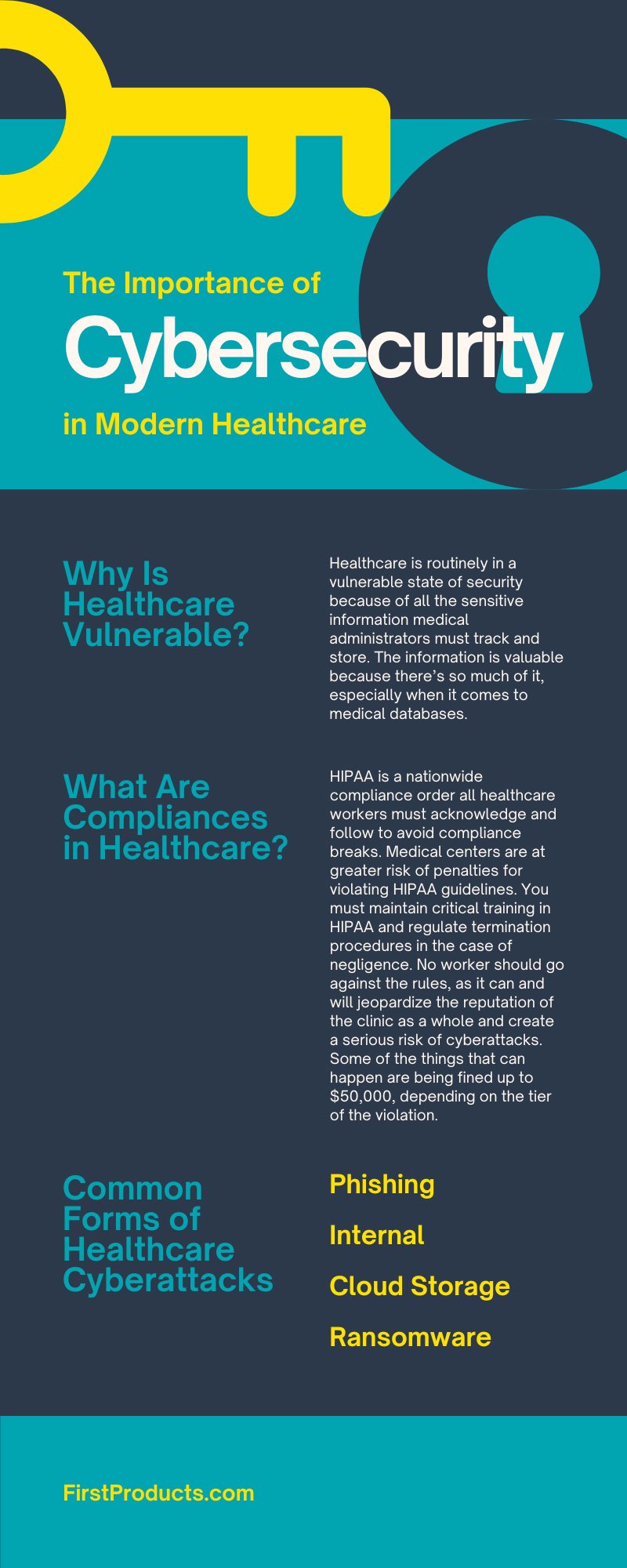By FHP on 2/22/23 3:33 PM
Healthcare has seen great advancements as of late, with innovations ranging from telehealth communications to enhancing the technology that medical workers use to treat patients daily. The unfortunate reality is that modern healthcare is being subjected to an increasing number of cybersecurity issues.
These problems stem from vulnerable tech equipment, such as email communications, patient portals, and unauthorized access to personal records. These issues manifest into worse consequences for hospitals, one of them being issues with compliance. Here is an overview of the importance of cybersecurity in modern healthcare.
Why Is Healthcare Vulnerable?
Healthcare is routinely in a vulnerable state of security because of all the sensitive information medical administrators must track and store. The information is valuable because there’s so much of it, especially when it comes to medical databases.
The individuals most threatened by healthcare security breaches are the patients. Despite the confidentiality vulnerability of medical care, let’s go over who cybersecurity protects.
Who Does Cybersecurity Protect?
Cybersecurity protects everyone, including patients and healthcare providers. IT security safeguards every part of a hospital, down to security doors and cameras. A strong network security team can prevent breaches for healthcare workers and their patients.
How Cybersecurity Helps Patients
The benefit of computer safety is instilling barriers to protect against information leaks, such as identity theft and unauthorized access to personal accounts to order expensive medications through a patient’s credit card. Patients often take the biggest hit in an informational breach because their information is valuable to an attacker.
Setting up an e-pay system prior to appointments prevents identity theft and hacking into monetary accounts. Before indoctrinating an e-pay system, ensure your patients understand its use and how they benefit from e-pay methods.
How Security Networks Help Medical Facilities
Medical facilities are at a considerable disadvantage to cybersecurity threats. Since clinics connect with different vendors for medical purposes, many attackers might masquerade as one to slip past specific barriers to steal vulnerable information.
Many facilities have taken things into their own hands by hiring a chief information security officer who makes most of the harder decisions for cybersecurity. They also help plan training sessions to educate all staff on network security best practices.
What Are Compliances in Healthcare?
HIPAA is a nationwide compliance order all healthcare workers must acknowledge and follow to avoid compliance breaks. Medical centers are at greater risk of penalties for violating HIPAA guidelines. You must maintain critical training in HIPAA and regulate termination procedures in the case of negligence. No worker should go against the rules, as it can and will jeopardize the reputation of the clinic as a whole and create a serious risk of cyberattacks. Some of the things that can happen are being fined up to $50,000, depending on the tier of the violation.
What Are the Violation Tiers?
The first-tier violation states that hospitals and clinics could face between $100 to $50,000 for every violation they weren’t aware of or could they have prevented. The second tier shows medical facilities that should’ve been observant of potential attacks, even if they couldn’t prevent them but still attempted; second-tier violators face a fine between $1,000 and $50,000 per offense.
Tier three states that workers who have known of these attacks and made little attempts at stopping the breach could face varied fines ranging between $10,000 to $50,000 per violation.
The fourth tier refers to a gross negligence regarding network security. This tier is the highest offense a medical center can make, leading them to fines of $50,000 or more per violation.
Common Forms of Healthcare Cyberattacks
Cyberattacks are frequent in every industry, but the healthcare field experiences internal phishing, cloud storage, and ransomware most frequently. Being aware of these attacks and creating safeguards can reduce the chance of the network being hacked and leaking personal and sensitive information.
Phishing
Phishing is a type of cyberattack hackers use to camouflage themselves as a reputable business or person of contact. Phishing attempts are often disguised as official emails, and the best way to know if an email is phishing is to look over the email’s grammar and spelling. The formatting can also be an indicator that the email might be spam or phishing.
These emails are used to steal sensitive information, including patient information, security codes, and card info. You can prevent this by flagging the email, which allows your IT department to take the messages down before someone clicks on a link or hits “Reply.”
Internal
Internal threats can happen, too—and right under your nose. Let’s take an examination room, for example. Doctors and nurses might leave a program open by accident, leaving patients vulnerable to having sensitive information stolen and leaked. You can safeguard every exam room computer by setting up logins for every device; when a doctor logs out, no one else will have access to their notes without knowing the login.
Cloud Storage
Cloud storage typically receives the most hits on HIPAA violations. Cloud storage is vulnerable because it goes through servers in order to save to the cloud. These servers can be hacked into, creating vulnerabilities in data—and this is where many data breaches and leaks happen. The best way to prevent cloud storage hacking is to build private clouds with encrypted passcodes workers use to access.
Ransomware
Ransomware affects devices such as computers and tablets. And as its name implies, most information can be reobtained by paying cash to the intruder. However, even paying a monetary value won’t always give the information back—and it doesn’t stop the user from divulging sensitive information, either.
The best solution to ransomware protection is to frequently back up your files and install security software with ransomware protection on every device. Utilize training sessions for every employee to practice preventing ransomware.
Tips on Improving Cybersecurity in Healthcare
Great news! It’s possible to improve cybersecurity in your healthcare facility. Every modern healthcare center needs to know how to prevent cybersecurity threats from happening. Here are some tips to improve your network security best practices.
Be Aware of Email Communication Malpractices
Many medical settings utilize email as a preferred communication method, including messaging patients through telehealth programs. When you’re replying back or creating a new message, ensure that the links you provide don’t lead to a public area of a website or portal. Additionally, opening and clicking on links in spam emails is risky.
Start shooting for no dice by flagging the email so IT can grab hold of the spam before anyone clicks it by accident. Additionally, you can reach out to higher-ups regarding emails they may have sent, especially ones asking for sensitive information from a patient. No doctor would ask for information like a patient’s social security number or credit card details, so be sure to flag this type of threat immediately upon receiving it.
Train Staff on Identifying Security Threats
It can be hard to identify security threats, especially in email. You can train your staff to identify security risks using real-world examples to spot scams. Additionally, you can create hard copies and PDF files of which persons to alert in case of a potential cyberattack.
The other thing to do is invest in smart medical chart supplies from First Healthcare Products. Our supplies keep everything in the medical center organized and safe from potential security risks. Improve the security of your most vulnerable information by upgrading to modern medical conveniences.

_11wX8.5h-FINAL.png?width=721&name=FP-Logo-Horizontal-(COLOR)_11wX8.5h-FINAL.png)


comments